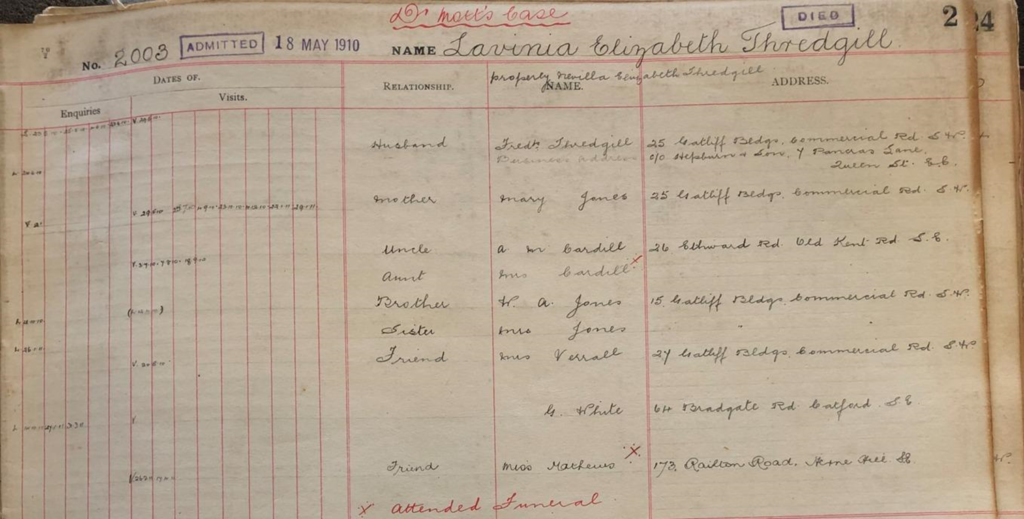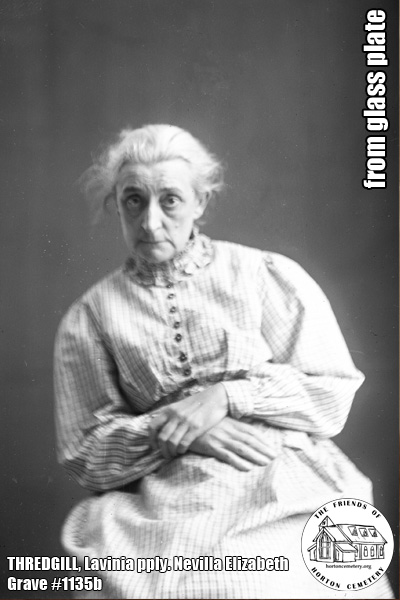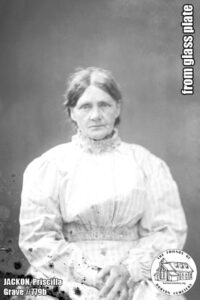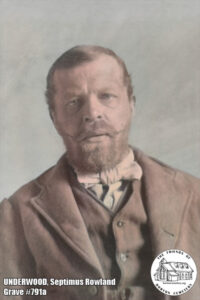b.1858-d.1911
Note: The unusual name has several different spellings throughout the archived documents. Lavinia pply. Nevilla Elizabeth Thredgill is the name on the burial record.
To research Navelia’s story, I first found her birth record on the General Register Office website. Her maiden name was Jones and her first name appears to be transcribed on the birth record, giving her name as ‘Navilia’ instead of Navelia. It states that her mother’s maiden name was Condell.

Navilia’s parents
Navilia’s parents, Mary Condell (b.1834) and William Jones (b.1832) were married on 2 September 1857 in St John Horselydown in Southwark. William’s occupation is given as a tobacconist, which would have been someone in a shop selling tobacco products. Mary’s father’s occupation is listed as a gentleman, while William’s father was a publican. They appear to only have had two children together:
- Navelia Elizabeth (b.1858)
- William Alfred (b.1861)
It was unusual that Navelia’s parents only had two children during this period. In 1860, the fertility rate was 4.89 in Britain. Perhaps they had more children that didn’t survive but I have been unable to find any record of them.
The 1850s
Navelia was born in March 1858 in the parish of Saint Mary Magdalen in Bermondsey, which was then in Surrey. Navelia appears to have been named after her paternal aunt, her father’s sister, who was called Neveilla Elizabeth (b.1833).
She was baptised on 8 August 1858 in St Paul, Bermondsey. They were living at 3 Molesworth Square in Bermondsey at this time.

Navelia’s baptism certificate.
The 1860s
In the 1861 England Census, along with her parents, 3-year-old Navelia is visiting her 58-year-old grandfather, Alfred Condell, who is living at 42 Maze Pond in Southwark, along with his daughter, four sons and two lodgers. It states that Alfred works at the coroner’s office. Interestingly, it states that Alfred was born in roughly 1800 in Madeira.
The 1870s
In the 1871 England Census, 13-year-old Navelia is living at 75 Falmouth Road in Newington with her parents and brother and a boarder, George Lowers. In Charles Booth’s poverty map, Falmouth Road is described as ‘Fairly comfortable. Good ordinary earnings.’ to ‘Middle class. Well-to do.’
The 1880s
In the 1881 England Census, 23-year-old Navelia is living at 75 Falmouth Road in Newington with her parents and brother, whose occupation is given as a farrier’s assistant. They are also living with three boarders, Stanley Akers, Edward H. Clark and Fred Threadgill. It states that Fred’s occupation was a law writer. We know that Navelia went on to marry Fred only four years later in 1885.
According to the Civil Registration Marriage Index, Navelia married Fred Threadgill in 1885 in the parish of St Saviour Southwark in London.
In April 1887, Nevilla’s brother, William, married Susan Watts at St Thomas in Marylebone. Their marriage certificate states that Nevilla and William’s father’s profession is a solicitor’s clerk. William and Susan went on to have at least two children together, Mary Elizabeth (b. 1888) and William Alfred (b. 1891).
The 1890s
In the 1891 England Census, 30-year-old Nevilla is living at 75 Childeric Road in Deptford St Paul with her husband, Fred. His profession is still given as a law writer.
Nevilla’s parents are still living at 75 Falmouth Road in Newington with three lodgers. We know that her father, William, died sometime between 1891 and 1901 but I have been unable to find the specific date as William Jones was such a common name.
Nevilla’s husband, Fred, was admitted to the workhouse in Stepney, Tower Hamlets on 26 November 1894 and discharged on 1 January 1895. The Workhouse Admission and Discharge Records state that his cause for admission is ‘rheumatism’. This could be the start of the General paralysis of the insane (GPI) that would he would ultimately die from in 1913.
The 1900s
In the 1901 England Census, 43-year-old Navelia is living at 25 Gatliff Buildings in the parish of St Barnabas in Pimlico with her 67-year-old mother, Mary, who is stated to be widowed and ‘living on own means’. It states that Nevilla is married, which leads us to speculate where her husband, Fred, is living at this point. It does not give a profession for Nevilla. Gatliff Buildings were erected in 1866-67 by the Metropolitan Association for Improving the Dwellings of the Industrious Classes, so presumably, this would have been a reasonably nice place to live during this period.
In the 1901 England Census, Fred is shown to be living at 6 Erlam Road in Deptford St Paul with his new wife, Kate Harriet Grace Threadgill (née Sheppard), despite his other wife Nevilla still alive and living with her mother. As I have been unable to find a marriage certificate for Fred and Kate, they likely had an informal marriage where she took his surname and they cohabited. Fred and Kate went on to have a son, Frederick Victor, in 1905, who was born in Greenwich.
The 1910s
Nevilla was admitted to Fulham Road Workhouse on 9 May 1910 and discharged on 18 May, which was when she was admitted to Manor Asylum in Epsom, Surrey. On the record, it gives Navelia’s occupation as a charwoman, which is surprising as none of the censuses stated that she was a charwoman. Her name is mistakenly given as ‘Lavinia’, a name which hadn’t been used up until this point, and her surname was misspelt as ‘Thredgill’.

The London, England, Workhouse Admission and Discharge Records showing Navelia’s admission to Fulham Road Workhouse.
Nevilla was admitted to the Manor Asylum in Horton, Surrey on 18 May 1910. Sadly, Nevilla’s case notes are from one of the case books that is missing from the archive (Case Book 13, Entry 53), so we don’t know what her symptoms were or why she was admitted to the asylum.

The UK, Lunacy Patients Admission Registers showing Navelia’s admission at Manor Asylum.
Nevilla died on 18 April 1911 at Manor Asylum in Epsom, Surrey aged 53.

Nevilla’s death certificate.
Nevilla’s death certificate gives her cause of death as ‘Valvular Disease of heart’ and ‘Carcinoma Uterus’, which today is known as womb (uterus) cancer. The informant of her death was the superintendent of Manor Asylum Epsom, rather than a family member. Her profession is given as a charwoman and it states that she is the wife of Fred Thredgill.
The Visitors’ Register for Manor Asylum shows Nevilla’s family and friends who either enquired about her or visited her – her husband, mother, uncle, aunt, brother, sister-in-law, and three friends. It shows that only Nevilla’s aunt, Mrs Condell, and her friend, Miss Matthews, attended her funeral. Fred Thredgill did not attend; however, he was in an informal marriage with another woman by the time Nevilla died and suffering from ‘rheumatism’. It is interesting that at one time, Nevilla, her husband, mother, brother and sister-in-law, and friend all lived in Gatliff Buildings on Commercial Road in Pimlico.

The Visitors’ Register for Manor Asylum showing Navelia’s visitors.
Nevilla’s husband Fred died only two years later at London County Asylum in Dartford, Kent on 23 January 1913, aged 53. His death certificate states that he died of ‘General Paralysis Duration prior to admission’. GPI is caused by late-stage syphilis. It gives the informant of his death as Kate Threadgill, his widow. Navelia’s death certificate doesn’t mention GPI, so it is unlikely that Fred passed on his illness to her.

Fred Threadgill’s death certificate.
AUTHOR’S NOTES
As both Nevilla’s first name and surname after marriage were quite rare, I saw lots of different variations in the spellings on the censuses. Although I was given her first name ‘Lavinia’ when I first started researching, this name did not crop up anywhere until she was admitted to the workhouse and then the asylum.
Interestingly, Nevilla’s husband got remarried while his first wife was still alive. Historian Dr Ginger Frost argued that most communities accepted bigamous unions if they followed certain norms, such as supporting both families and being honest with their second wife, following in a long tradition of self-marriage and self-divorce. It is very sad that Fred did not attend his wife’s funeral but perhaps he was already ill by this point.




